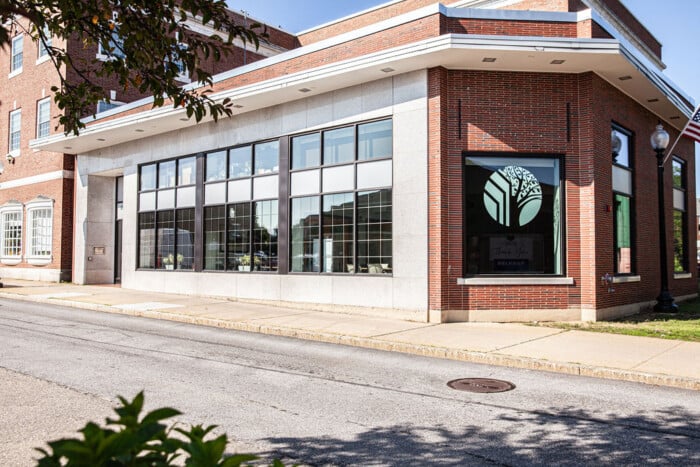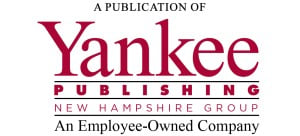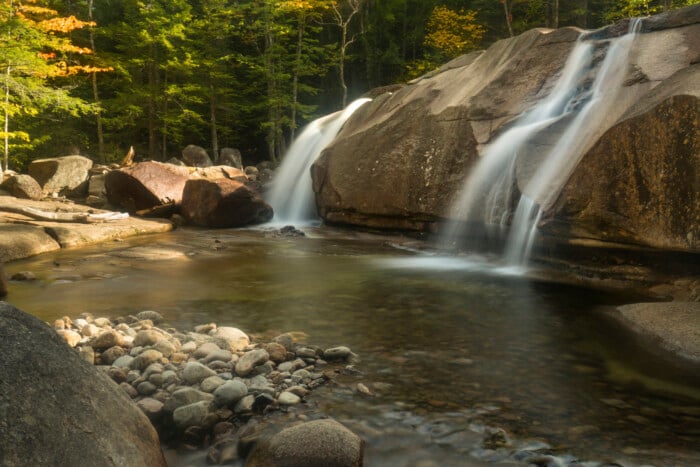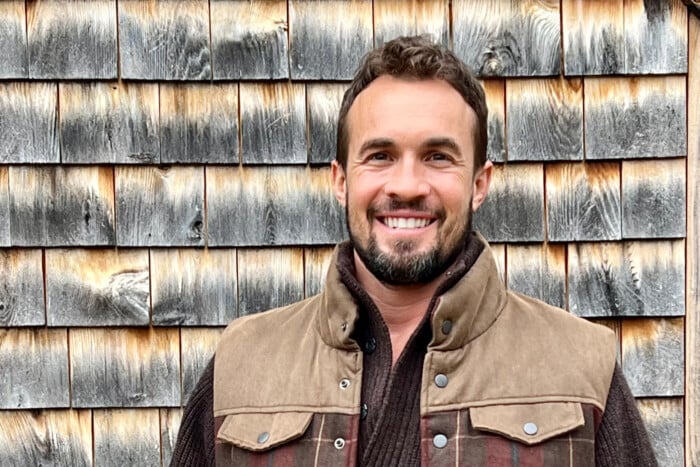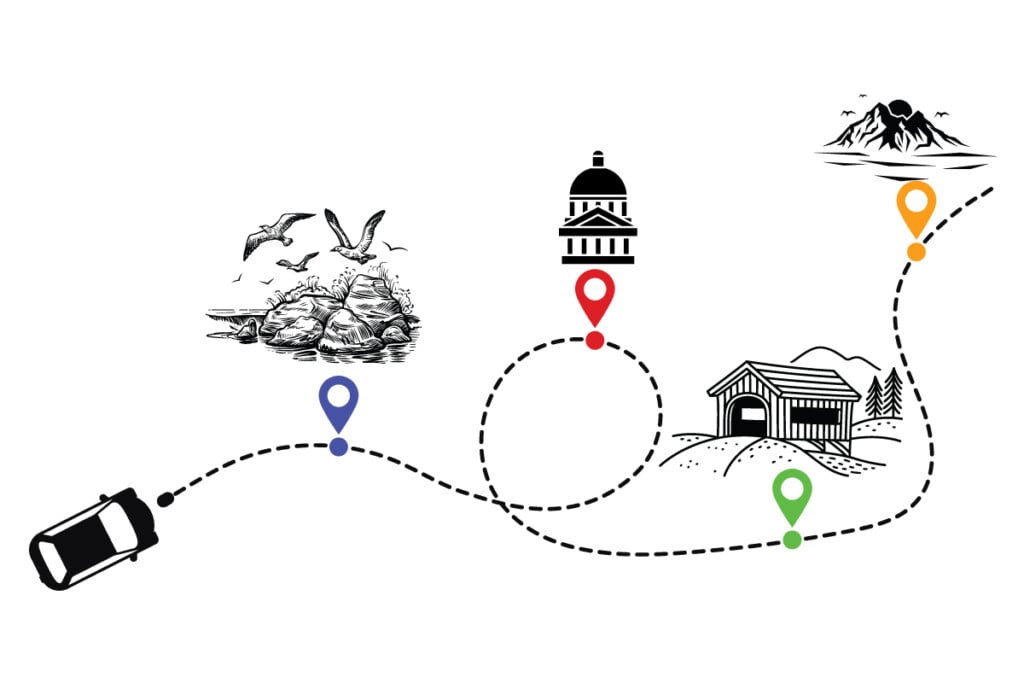How NH Really Started: A 400th Anniversary Return to 1623
Precious little is known about the first tiny group of English settlers who arrived aboard the Jonathan in spring 1623. They set up a fortified fishing and trading post at Little Harbor, now Odiorne State Park, in the town of Rye, New Hampshire
After 400 years, it’s time to face facts. The founding of New Hampshire was a flop. There, I said it. Don’t shoot the messenger.
We’ve been bending reality for centuries. Our founding English couple, David and Amias Thompson, landed at what is now the town of Rye in 1623. But they soon moved to Boston. Seven years later, what we now call Portsmouth began as a mining colony. Captain John Mason, the so-called “father of New Hampshire,” also hoped the Piscataqua River might be the fabled waterway through the continent to the riches of the Orient.
When no valuable metals, precious stones or Northwest Passage appeared, Mason dropped dead and his investors panicked. They shut down the company and abandoned the Strawberry Bank colonists 3,000 miles from home.
So what exactly have we been celebrating with parades, poems and pageants since 1823? Can New Hampshire handle the truth? Let’s find out.
Back to the Beginning
By 1605, early European explorers named Gosnold, Pring and Champlain had sailed in and around the Piscataqua River that separated future New Hampshire from future Maine. But settling New England, then known as Northern Virginia, was not high on the to-do list of King James I. In 1603 James succeeded Queen Elizabeth, who, trivia buffs will recall, had imprisoned and beheaded James’ mother, Mary, Queen of Scots. Although well educated (he authorized a popular new translation of the Bible), King James was known as “the wisest fool in Christendom.”
“The weak monarch,” according to one historian, “was more interested in getting a hawk or flying squirrel from the New World than colonizing it.”
That was good for the People of the Dawnland, who had occupied the region for over 12,000 years. But oddly dressed white men in enormous ships were showing up along the coast with concerning frequency. In 1605, one of those men, Captain George Weymouth, was documenting the abundant fish, fowl, plants, timber, rivers and harbors off the Maine coast. Near Penobscot Bay, Weymouth and his crew abducted five Abenaki warriors; Amóret, Tahánedo, Manedo, Skicowáros and Sassacomoit were taken across the sea to the fort at Plymouth, England. Weymouth presented three of the kidnapped Natives to the most influential figure in the colonization of New England.

History has left us no images of the Thompsons or Sir Ferdinando Gorges, but this portrait by Flemish painter John de Critz shows King James I (1566-1625) in all his splendor. A reluctant colonizer, James authorized the Council for New England to grant lands it did not own to potential American settlers. Courtesy Wikimedia Commons
The Gorges Connection
What? You never heard of Sir Ferdinando Gorges? A former soldier, Gorges was then governor of Plymouth, a post previously held by English privateers Sir Francis Drake and Sir Walter Raleigh. Gorges was overwhelmed by the highly intelligent indigenous Americans who lived in his household for the next two years. They were, he later wrote, “far from the rudeness of our common people.”
It is here that Gorges “caught the colonization fever,” according to New Hampshire historian Charles E. Clark. “From that moment until he died 42 years later, Gorges’ life was dominated by a single passion: to sponsor colonies in the place described to him in broken English by his homesick captives,” Clark wrote.
The French, the Spanish and soon the Dutch were planting fortified settlements in North America. King James was unable to fund a similar effort, but he was happy to let private investors risk their money. We all know about Jamestown, Virginia, and Captain John Smith, whose life, according to legend, was saved by an 11- or 12-year-old Pocahontas (her real name was Amonute). The Jamestown experiment was disastrous. Hundreds of early colonists died from famine, disease and Indian incursions. Despite the discovery of tobacco as a cash crop, investors back in London suffered huge losses and eventually went bankrupt.
History texts rarely mention that King James also authorized a second investment group to explore the mysterious northern coast. In 1607, parallel to Jamestown, the Plymouth Company funded an expedition of their own. Led by Sir George Popham, a British customs officer and friend of Sir Ferdinando Gorges, 120 English men and boys set up operations in Sagadahoc, at the mouth of the Kennebec River in the territory of Maine.
The Popham Colony did surprisingly well. Despite a bitter winter, they built a fort, a storehouse, a church and 50 dwellings. They established trade with indigenous tribes and even constructed Virginia, the first English ship built in North America. But when George Popham died, the settlers returned to England.
Sir Ferdinando was devastated. “All of our former hopes were frozen to death,” Gorges wrote to a friend. It was but the first of many disappointments to come — including two in New Hampshire.
John Smith Sails Again
Failure at Popham and hard times in Jamestown cooled Gorges’ colonial fever. But by 1614, having abandoned Jamestown, Captain John Smith was exploring North America again. He hunted for whales and gold mines in the region he dubbed “New England.” Smith found no gold and could not catch a whale, but he was thrilled by the rich fishing grounds in the Gulf of Maine.
Smith was scarcely off the boat back in Plymouth, England, when he met with his “honorable friend” Sir Ferdinando Gorges. The two men planned Smith’s return trip to set up a plantation near what the famous adventurer called “Smith Isles” (the Isles of Shoals).
“Could I have but means to transport a colony, I would rather live here,” Smith wrote. His three attempts, however, were ruined by bad luck, bad weather and French pirates. Gorges lost interest in the unlucky John Smith and turned his attention to other adventurers — including the two “founders” of New Hampshire.
It was Captain Smith, curiously, who got Gorges back on track. Smith’s bestselling book, “A Description of New England” (published in 1616), not only gave the region its new name and a map, but reinvigorated investor interest. Settlers might discover gold, pearls and jewels in New England, Smith predicted. But the real money, he wrote, was in the long game of fishing, farming, lumbering, shipbuilding and trading with the Indians.
Inspired by Smith’s sales pitch, Ferdinando Gorges bankrolled a team that wintered near what is now Biddeford, Maine. He also sent fishing crews to Monhegan Island and the Isles of Shoals. Things were looking up.
In November 1620, even as the Mayflower reached the frigid coast of Cape Cod, King James finally decided it was time to colonize America. Authorized by the Crown, Gorges assembled a group of 40 investors, mostly wealthy nobles, into “The Council Established at Plymouth for the Planting, Ruling and Governing of New England in America.” The name says it all. David Thompson and John Mason were on the short list.

David and Amias Thompson of Plymouth, England, were settling in “Pannaway” at Little Harbor when hot-tempered Pilgrim military leader Miles Standish arrived early in summer 1623. Thompson immediately sailed to New Plymouth with a life-saving boatload of fish for the starving Separatists. Illustration by Robert Squier from the forthcoming history comic “Portsmouth Time Machine” by the author. Copyright Harbortown Press
Other People’s Money
Every early American colony, including that of the pious Pilgrims, was funded by rich sponsors hoping to get richer — fast. The Council for New England was no different. Badly managed and desperately underfunded, Gorges’ group granted about a dozen patents to land lying between the 40th and 48th degrees of north latitude — land they did not own. In 1620, New England technically included all modern territory between Nova Scotia and North Carolina, stretching westward across the entire continent to the Pacific Ocean.
One of the first patents issued — no surprise — was to Ferdinando Gorges and his friend John Mason, another former soldier. Mason was from the city of Portsmouth, England, in Hampshire County. In 1622 the two men claimed all land from the Merrimack River on the New Hampshire-Massachusetts border to the Kennebec River in Maine. But they did not make any effort to set up a colony then, a fact that confused future historians.
The honor of first New Hampshire settler fell to David Thompson (also spelled “Thomson”) who received his grant in November of 1622. Records show he was baptized in 1592 at St. James Church in Clerkenwell, a medieval parish of central London. Despite unsupported rumors, we know nothing about David’s early life. He reappears in 1613, married to Amias Cole (also “Colle”), the 16-year-old daughter of a Plymouth shipwright. Two of their four children survived.
How David Thompson was connected to the powerful Ferdinando Gorges remains unclear. His name appears in Council records as perhaps a messenger or clerk. Often typecast as a fisherman, he was actually an apothecary or pharmacist. We know this thanks to a rare “indenture,” or deed, unearthed in the early 20th century.
In 1615, William Cole, David’s father-in-law, leased the young couple a roomy second- floor apartment in downtown Plymouth, England. It included an office for the “aforesaid apothecary” and “his now wife.” Seven years later, borrowing funds from three prominent Plymouth merchants, the Thompsons abandoned their comfortable home for the harsh American wilderness, never to return.

Recent archaeology digs at the Isles of Shoals prove that seasonal English fishermen were splitting, salting and drying codfish here in the 1620s. This image is by Bill Paarlberg from the author’s book “Under the Isles of Shoals.” Courtesy Harbortown Press
Little Harbor Home
New Hampshire’s first European settlers stepped ashore somewhere between what is now the playground and the boat launch at Odiorne Point State Park in the town of Rye. Unlike the Mayflower Pilgrims who, three years earlier, were headed to the Hudson River but ended up settling in Massachusetts, Thompson was not lost. He wasn’t escaping from anyone or seeking religious freedom. His motivation was commercial. He had the king’s blessing. And he arrived, not in November at the onset of a brutal New England winter like his New Plymouth neighbors, but at the peak of the fishing season in the warming days of spring.
Scholars did not rediscover Thompson’s patent (or “indenture”) with the Council until the 1870s. In exchange for running an operation for five years, he and his crew would receive 6,000 acres of land and an island of his choice. He would not live to cash in.
Whether Amias Thompson, her retinue of servants and her four-year-old son John arrived aboard the Jonathan at the same time is unknown. (They left their only daughter in England.) Nor do we know the names of any of the fishermen — between seven and 10 men — who helped build the Little Harbor operation.
According to a contemporary witness, Thompson constructed “a strong and large home” surrounded by a tall wooden fence mounted with guns. Pannaway, as the outpost is known to history, “was a terror to the Indians.”
The Real 1623
New Hampshire’s origin story overturns the Thanksgiving myth that Pilgrims and their indigenous neighbors lived in harmony. In late March, as the Thompsons were settling on the Piscataqua, Separatist leaders feared an attack. Massachusett warriors, it was rumored, were planning to destroy a small English trading colony called Wessagusset, about 30 miles north of New Plymouth. Would they also wipe out the Pilgrims?
Miles Standish, the hot-tempered Pilgrim enforcer, led his eight-member militia to Wessagusset. Discovering the English colony still intact, Standish invited tribal warriors to attend an impromptu peace negotiation. During a meal, Standish stabbed a warrior named Pecksuot with his own knife. Seven Natives were slaughtered in the “pre-emptive attack.” Hailed as a hero, Standish mounted the severed head of the warrior Wituwamat on the roof of the Pilgrim fort. Their population already decimated by a European-borne pandemic, the First People of Cape Cod abandoned their crops and hid from the English “cutthroats.”
All the Wessagusset colonists fled to fishing outposts at the Isles of Shoals and Monhegan seeking shelter or transportation home to England. Among them, Phineas Pratt relayed the bloody news to David Thompson in person. Scarcely three months later, Miles Standish himself appeared at Pannaway. Due to a punishing drought, Standish reported, the starving Pilgrims were desperate for food.
Thompson immediately brought a load of fish to New Plymouth, an event documented by Separatist leaders. Edward Winslow described the apothecary as a “Scotchman” living “near Smith’s Isles at a place called Pascataqitack where he liketh well.” Refreshed by Thompson’s delivery and a drenching rain, Winslow wrote, the congregation offered prayers of thanksgiving for proof that they were among God’s chosen people. (The Pilgrims, by the way, referred to themselves as “saints” and all others as “strangers.”)
Word of the Wessagusset massacre and tales of renegade English fishermen soon reached England. The Council, in response, sent Sir Ferdinando’s young son Robert Gorges to bring order. Robert, named governor-general of the entire region, arrived at Little Harbor late in 1623 or in the spring of 1624. Explorer Christopher Levett recorded the meeting in which David Thompson was appointed deputy governor.
Robert Gorges and a boatload of settlers intended to establish an Anglican colony at or near Wessagusset. His timing could not have been worse. Letters from his father in England revealed the Council was struggling financially and could not send further supplies. Wars with France and Spain appeared imminent. Unsuited as both a leader and a pioneer, Robert Gorges abandoned his colonists and returned to England where he died in obscurity. Christopher Levett, too, left for home, leaving David Thompson (on paper, at least) as governor. For a brief forgotten moment, Pannaway was the capital of New England.

Unlike seasonal fishermen who set up temporary staging areas at the Isles of Shoals, David Thompson settled on the mainland near modern day Rye, NH. After only three years, however, he abandoned New Hampshire and moved his operation to an island in modern Boston Harbor. Courtesy Natalie Schorr, Dreamstine
A Body Without a Head
Two years after landing in New Hampshire, David Thompson was disappointed and scared. The danger was coming — not as much from pirates, wolves or Indians, but from the English. In a 1625 letter all but ignored by historians, David reported that the Council’s efforts in America were failing. English settlers were selling guns to the Natives while drunken fishermen were committing “vices I dare not name” against indigenous people.
Land grants issued by the Council, he warned, were scattered too far apart with no leader in charge. “We are like a body without a head, none to rule us,” he wrote. David suggested that John Mason, who had previously governed a fishing operation in Nova Scotia, would make an ideal governor in America. As to the isolationist Pilgrims of New Plymouth (David called them “Brownists”), they were interested only in themselves and “none regards them or their fellowship,” he wrote.
So David Thompson started over. By 1625 every settler realized that Boston Harbor was the perfect spot from which to grow New England. “No man need expect any better place than the Massachusetts,” he told the Council. By 1626, it appears, David was already building a second fortified trading post on a fertile 170-acre plot known today as Thompson Island.
Here David Thompson’s story ends. By 1628 he was dead at age 36, possibly drowned, but the true cause remains a mystery. Amias immediately married another English settler named Samuel Maverick of nearby Noddle’s Island, now part of Logan Airport.
In 1630, just two years after the Mavericks married, the Great Migration began. A flood of 20,000 English Puritans poured into the newly formed Massachusetts Bay Colony. When Reverend John Winthrop, Puritan governor of the “shining city on a hill,” arrived that year, the first people he met in America were Samuel and Amias Maverick at Noddle’s Island. Winthrop found Samuel to be “a man of a very loving and courteous behavior.” But as an Anglican agent of Ferdinando Gorges, he was also a threat.
Over the next two decades, Samuel Maverick was fined, jailed and eventually driven out of Massachusetts by Puritan courts. He later died in New York while Amias — New Hampshire’s unsung female founder — died somewhere near Saco, Maine, around 1672.

This extra-large fishhook, discovered by the author at the Isles of Shoals, indicates the size of the “Great Cod” weighing over 100 pounds that once flourished in the Gulf of Maine and sparked a bustling English fishing industry. Photo by J. Dennis Robinson
Strawberry Bankruptcy
Sir Ferdinando Gorges would not give up. Charles I, successor to King James, was bullish on colonizing New England, but equally short on cash. With David Thompson gone, the Council turned to Captain John Mason. On paper, Mason owned everything from the Merrimack to the Piscataqua rivers. At this point, a twist of fate inspired Mason to launch his own New Hampshire colony.
A little background is needed here. Unlike many English traders, the French had developed a relationship of mutual gain with the Natives, resulting in a booming fur trade along the St. Lawrence River in Canada. In 1629, while at war with France, English privateers forced the surrender of the French at Quebec City. A company of London adventurers petitioned King Charles for sole rights to trade in the newly conquered region of New France. But during treaty negotiations, England returned the captured territory to the French.
Gorges and Mason saw an opportunity. They had long hoped that the Piscataqua River might be the fabled Northwest Passage to the Orient. Perhaps, they now reasoned, it might also be an alternate route to the mighty lakes where the French and Indian fur trade was booming. Mason’s investors, the Laconia Company, were willing to try. On November 17, 1629, Mason’s latest patent granted him land bordering “the rivers and lakes of the Iroquois.” Scholars have suggested that the imaginary settlement of “Laconia” (land of the lakes) was modern-day Lake Champlain.
Mason’s plan made sense in 1629. Lake Champlain, a freshwater glacial body between Vermont and New York, is a mere 200-mile hike from modern day Portsmouth. Abenaki Natives told tales of an immense expanse of water within a few days’ journey inland toward the “Crystal Hills” (White Mountains) that were rich with glittering metal and gems.
Mason’s patent also included a thousand-acre settlement a few miles up the Piscataqua River. Strawberry Bank, it appears, was intended as a way station. Trade goods from Europe would be stockpiled at the landing site, now Portsmouth’s Prescott Park area. English traders in boats or canoes would travel upriver to Lake Champlain, carrying back the valuable furs for export.
It didn’t take long for Mason’s settlers to discover that the shiny stuff at the White Mountains was mica and garnet, two worthless minerals. Instead of Lake Champlain, the distant body of water was probably Lake Winnipesaukee. The tributaries of the mighty Piscataqua River, on further examination, only took the first settlers to a tidal estuary further inland. Bummer.
Undaunted, John Mason continued to instruct his colonists to keep searching for gold, silver or copper mines. His letter from England, dated May 5, 1634, shows he never gave up hope that the Piscataqua was the gateway to riches. “I have disbursed a great deal of money in the plantation and never received one penny,” he wrote to the manager of Strawberry Bank, “but hope if there was once a discovery of the Lakes, that I should, in some reasonable time, be reimbursed again.”
NH’s Puzzling Past
John Mason never saw Strawberry Bank, a colony that included the modern towns of Greenland, New Castle, Rye, Portsmouth and Newington, plus half the Isles of Shoals. When he died in 1635, the Laconia Company closed down, leaving a few dozen Piscataqua colonists to fend for themselves in the wilderness. Their independent spirit — some might say their “cantankerous nature” — still shapes the New Hampshire brand.
The Council for New England also expired in 1635. King Charles I appointed the now-elderly Sir Ferdinando Gorges as governor of the region. Gorges tried and failed to wrest control of New England from the increasingly powerful Puritans. He died in 1647. Two years later, King Charles was beheaded by Oliver Cromwell, “the Puritan Moses.” After a brief reign, Cromwell died. The story gets even more confusing from there. Over the next century, Massachusetts Bay Puritans, greedy royal governors, a series of kings and John Mason’s descendants all claimed ownership of provincial New Hampshire.

Before moving to the wilderness of future New Hampshire, David and Amias Thompson leased a second floor apartment in Plymouth, England. This photograph of the surviving Merchant’s House on St. Andrew’s Street is representative of the comfortable cosmopolitan lifestyle the couple gave up. David died within five years while Amias remarried and survived another half century in New England before dying, possibly in Saco, Maine. Courtesy Wikimedia Commons
Worse yet, our earliest historians were often wrong. In 1680, for example, Puritan minister William Hubbard mixed up the Thompson and Mason settlements in his “General History of New England.” Hubbard also suggested, against all evidence, that London fishmongers Edward and William Hilton arrived with David Thompson. Hubbard theorized that the Hiltons established a parallel outpost at Dover Point in 1623. Careful study, however, shows Thompson was dead and gone before the Hiltons set up their tiny outpost.
“Historical facts seem often to have lain, in Hubbard’s mind, in a loose and chaotic form,” New Hampshire judge and scholar Elwin Page wrote prior to the state’s 300th anniversary in 1923. “There is not a shred of proof that William and Edward Hilton came over with Thompson,” Page and others concluded.
Reverend Jeremy Belknap repeated Hubbard’s errors in the first published history of New Hampshire in 1784. As early state documents resurfaced in the 19th century, researchers tried to replace town legends with facts — an often fruitless task.
In the words of English dictionary writer Samuel Johnson, “Many things which are false are transferred from book to book, and gain credit in the world.” Hubbard’s unsupported claim caused a dust-up between Dover and Portsmouth during a New Hampshire bicentennial in 1823. Both towns held separate celebrations. Two centuries later, the feud continues and the debunked Hilton claim is still widely misreported.
To be honest, our 1823 bicentennial was a copycat affair. In 1807, up to 3,500 visitors attended the Grand National Jubilee at Jamestown, Virginia. Reviving the all-but-forgotten Pilgrim story in 1820, Plymouth, Massachusetts, claimed to be the spiritual and democratic heart of the nation. “We feel that we are on the spot where the first scene of our history was laid,” orator Daniel Webster proclaimed.
After three devastating downtown fires and the War of 1812, Portsmouth needed an economic reboot. Taking a page from the Plymouth playbook, the state’s only seaport staged a hastily planned anniversary celebration in 1823. But there was no cohesive origin story to promote. Instead, Portsmouth town leaders proudly announced the city was founded in 1623 by “merchant adventurers” in search of land and wealth. It wasn’t sexy, but it was true.
The Seacoast has been throwing anniversary parties ever since, marked by pageants, patriotic parades and souvenir publications, plus T-shirts and tote bags. But it’s hard to top a Mayflower replica, a mythical rock, a national holiday feast and a reconstructed Pilgrim village alive with costumed characters. David and Amias Thompson, for those who care to look, remain ghostly figures adrift in our stormy past.
J. Dennis Robinson is the author of over a dozen history books. His latest projects include “Portsmouth Time Machine,” a graphic history for kids illustrated by Robert Squier, and a myth-busting study entitled “1623: The Forgotten Arrival and Sudden Disappearance of NH’s Founding Family.” For updated info, please visit jdennisrobinson.com.



